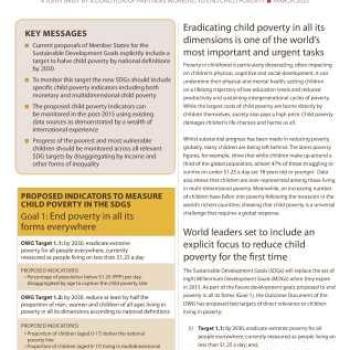
For the first time, the global community has recognised the centrality of child poverty to deliver on their promise to end poverty once and for all, and the need to ensure children are counted in the new post-2015 development goals. This constitutes tremendous progress as children have frequently been omitted from poverty goals and assessments.
As the discussion on the new goals moves quickly to the indicators that will be used to monitor the new SDGs, this new policy brief assesses how child poverty can be included as part of the new monitoring framework of the SDGs. In it, we provide specific recommendations to support member states frame the new indicators to help reduce child poverty in the new SDGs:
1. The current draft Post-2015 development goals and targets that include child poverty should include specific child poverty indicators
2. Indicators for child poverty reduction in the SDGs should include the following monetary and multidimensional poverty indicators:
- Percentage of population below $1.25 (PPP) per day, disaggregated by age to capture the child poverty rate
- Proportion of children (age 0-17) below the national poverty line
- Proportion of children (age 0-17) living in multidimensional poverty.
3. Child poverty targets should be reinforced with a new focus on equity to ensure the poorest and most disadvantaged children are reached and no child is left behind:
- All child-level indicators used in the SDGs should be disaggregated by income or wealth quintiles, ?monetary? and ?multidimensional? poverty status and other forms of inequality
4. Data collection for the most vulnerable children ? who are often omitted from or bypassed in surveys and programmes ? must be improved.
This brief was put together by a coalition of like-minded partners concerned at the devastating effects of poverty in childhood on children and societies, and the need to mainstream child poverty and the solutions to it in national, sub-national and global policies and plans.

For the first time, the global community has recognised the centrality of child poverty to deliver on their promise to end poverty once and for all, and the need to ensure children are counted in the new post-2015 development goals. This constitutes tremendous progress as children have frequently been omitted from poverty goals and assessments.
As the discussion on the new goals moves quickly to the indicators that will be used to monitor the new SDGs, this new policy brief assesses how child poverty can be included as part of the new monitoring framework of the SDGs. In it, we provide specific recommendations to support member states frame the new indicators to help reduce child poverty in the new SDGs:
1. The current draft Post-2015 development goals and targets that include child poverty should include specific child poverty indicators
2. Indicators for child poverty reduction in the SDGs should include the following monetary and multidimensional poverty indicators:
- Percentage of population below $1.25 (PPP) per day, disaggregated by age to capture the child poverty rate
- Proportion of children (age 0-17) below the national poverty line
- Proportion of children (age 0-17) living in multidimensional poverty.
3. Child poverty targets should be reinforced with a new focus on equity to ensure the poorest and most disadvantaged children are reached and no child is left behind:
- All child-level indicators used in the SDGs should be disaggregated by income or wealth quintiles, ?monetary? and ?multidimensional? poverty status and other forms of inequality
4. Data collection for the most vulnerable children ? who are often omitted from or bypassed in surveys and programmes ? must be improved.
This brief was put together by a coalition of like-minded partners concerned at the devastating effects of poverty in childhood on children and societies, and the need to mainstream child poverty and the solutions to it in national, sub-national and global policies and plans.

